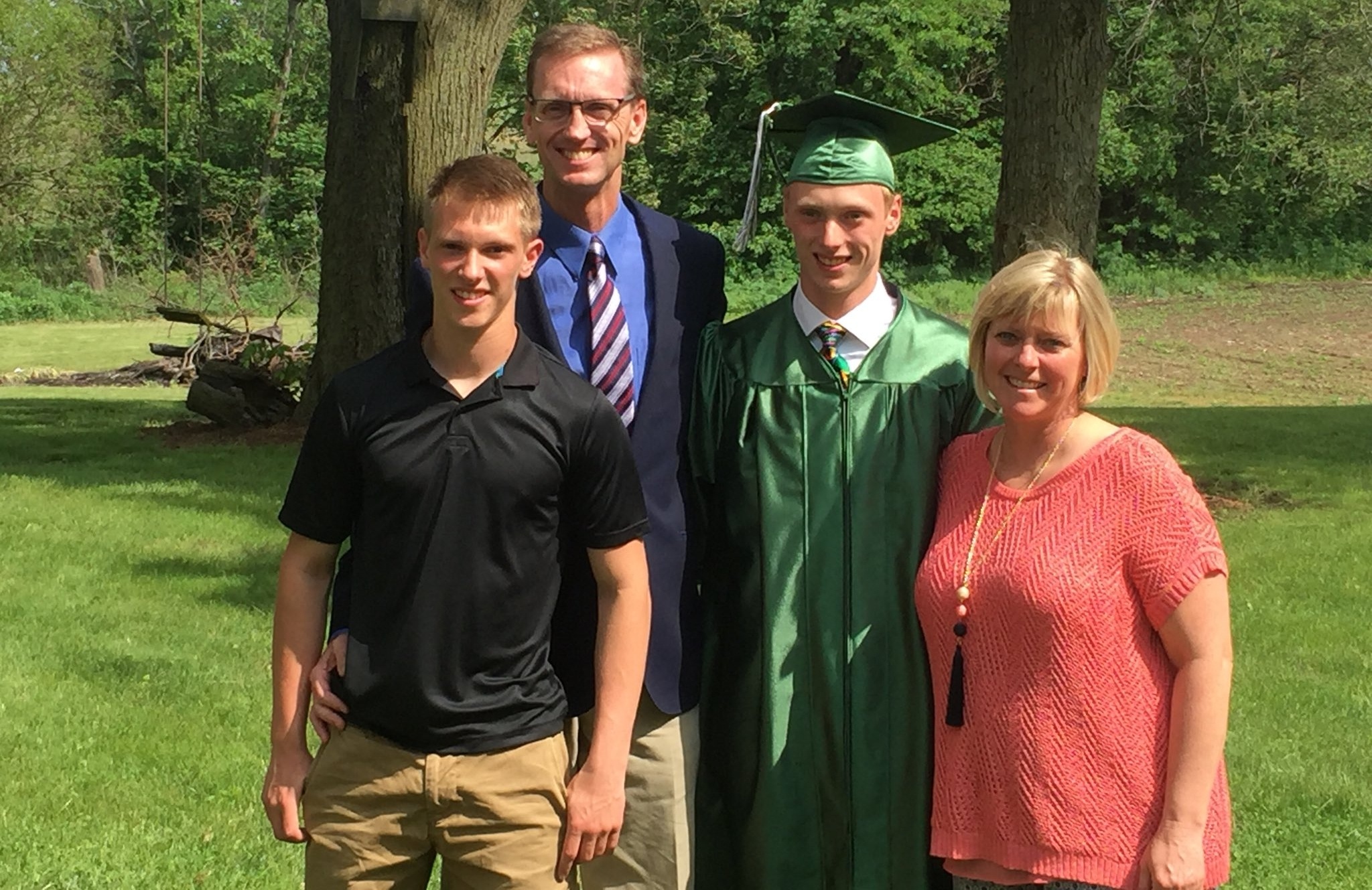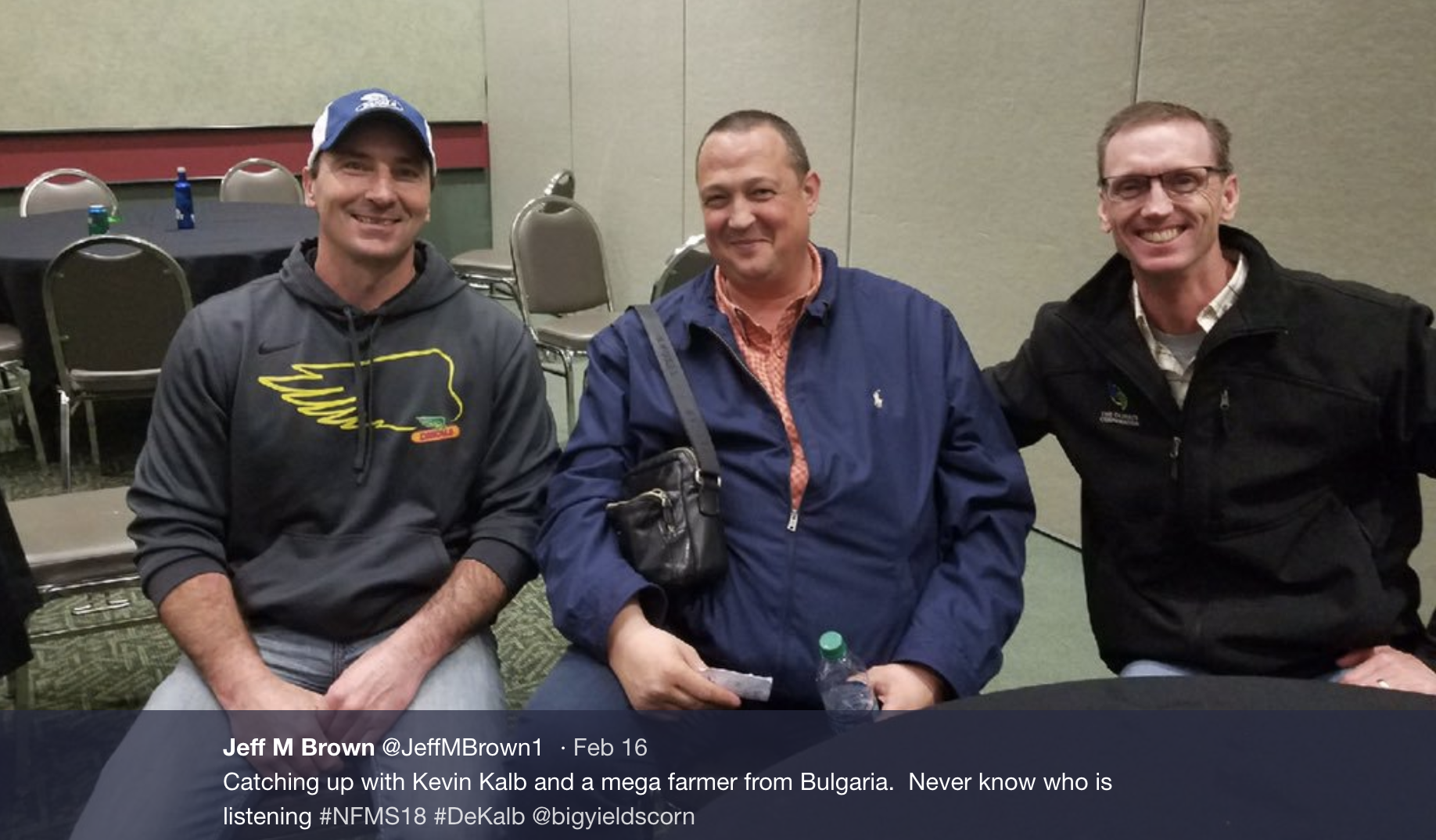Jeff Brown, “Mr. 350,” got his nickname by growing 350 bushels per acre of dryland corn in 2014, first place for Illinois and third in the nation. Brown, who farms in Blue Mound, Illinois, spoke with Ceres Imaging about his expectations for this season, and his farming philosophy and approach to new ag technologies. You can find him on Twitter @JeffMBrown1.
Q. How long has your family been farming in Illinois?
JB: We’re a fifth-generation farm family--I’m fifth, my sons are going to be the sixth. Been around for a long time.
This will be my 24th freshman year of farming. Every year you better consider yourself learning, because every year’s different.
We’ve always been in the south-of-Decatur, Blue Mound area. There’s me, my father, grandfather, great grandfather, great great, and great great great...so three great’s covers it.
In 1859 they came here from Ohio, and once some of them got established they went into Kansas. I’m glad I ended up in this area.
They grew everything...they had horses, they had livestock, they used oats, straw, wheat, corn. Beans didn’t really come til the 50s. They used a lot of hay for feeding and wheat, oats, things like that.
Q. It’s early, but how is this year looking?
JB: Well right now it looks like one of the best crops I’ve ever seen. We’re at basically V4, V5 corn, it’s still below our knees. I’ve never seen it crop this good since 2014, which was a record-breaking year for us by a lot.
It depends what’s going to happen the rest of the summer. Cool nights, nice cool days, in August during filling will be what gave us success in ‘14.
You can’t change the weather, but right now I’m evaluating the crop, figuring out what I need to do from the standpoint of putting more inputs on or not putting more inputs on. Trying to weigh market forces versus agronomic practices.
Q. Are there any applications that you like a lot or consider undervalued by many farmers?
JB: There are several, and the first one would be Y-drop application of nitrogen.
Mid-to-late season nitrogen application and then using the Y-drop is a tool some people are using, more all the time, for distribution of the nitrogen near the root structure so that as moisture takes nitrogen down, it’s right where it needs it instead of the middle of the row.
Splitting my forms and my applications of nitrogen is a more cost-management practice, but usually has a better return on investment than single-shot or double-shot (nitrogen).
Q. How would you describe yourself as a farmer?
JB: I’m a conventional-till, and always looking to try the next newest technology out there.
Technology is what’s going to take us to the next level. In the commodity world we live in, global economics, we’re competing against every other farmer in the world. We need to grow our crop at less cost per unit, not less cost per acre, less cost per acre.You can either decrease your cost or increase your yield. I try to increase my yields...because as you increase yield, you decrease your fixed costs. A little simple economics there gives me how I want to do things.
It was a change to the family to maximize some things we hadn’t use before but now we’re using those as standard practices, because they work.
That’s what we need to do to stay viable for the next generation and the next generation.
Q. How do you decide what to grow in a given year on your acres?
JB: We’re more back to a 50/50 rotation of corn and beans. The last two years I decreased our amount of corn because the profitability of soybeans has been very, very good compared with corn.
We mainly raise three crops, used to, we raise corn on beans, beans on corn, and corn on corn. Each one of those crops has to be treated uniquely.
Q. What advanced management practices do you rely on?
JB: When you get to that higher level of management, you have to take it field-specific, area-specific. You really zero in on those areas.
Tissue testing, Ceres Imagery-- I can’t wait to get my first (aerial imagery) shots of the year back.
I know what I know, I want to know what I don’t know. I don’t want to do it the same as I did it last year, I want to get some new field insights.
It’s a continual learning process. The whole reason I’m (using aerial imagery) is to learn what I don’t know and to see things like I’ve never seen them before.I just walked away from a guy that was flying a big drone, it’s brand new, first time they’ve done this. I’m so glad I don’t have to mess with that, batteries and all that. One, I don’t have time, and there’s no way it can cover the kind of acreage I have with that.
Q. You won the National Corn Growers Association in 2014. Are you in the competition every year? What does the competition mean to you and the other growers who compete?
JB: The reason I do this is not to win contests. The reason I do this is to improve myself, improve my knowledge, and then by doing that I improve profitability for not only me but for people with land who trust me to help them farm it.
There’s only a few of us who are fortunate enough to have this job and opportunity and I do not take that lightly at all.
Q. What do you enjoy most about farming?
JB: It’s a challenge, I’m pretty competitive. It’s not me against my neighbor, but it’s me against myself. It’s me trying to strive to do a better job. Trying to teach my kids, who are interested in ag. I’m fortunate to have that, that they want to become farmers or ag professionals down the road.
You always want to leave this place better than you got it, something that you pass down generation to generation. I take my responsibility very seriously on that.
The reason my kid’s going to the college he is, is because it’s a small ag school that’s flexible, compared to some of the other ag schools he could have gone to. It’s Illinois College in Jacksonville, it’s the oldest college in Illinois. As fast as ag is changing, they’re able to change with it and stay abreast.
It’s not what he learns, but how he thinks. It’s thinking outside the box, challenging the norm.

I challenge myself every day not to do the same thing over. It’s thinking outside the box and trying new things. That’s the fun part. Sometimes you succeed and sometimes you fail, but as long as you learn, you never fail.
The bottom line is you’ve got to be able to change with the times, keep abreast of new technologies to propel yourself into the future. It’s challenging to do that. Everybody has their own comfort level, you have to step outside your comfort zone to pursue things.
Through my years of working in different areas of ag, I’ve met a lot of people and I just try to learn and ask questions of them.
I just met with some consultants, and they said “What is your yield goal?”I said “My yield goal is 351. But if we don’t learn anything from this, we didn’t do very good.”
We’ve got to keep learning how to grow corn.
Q. Who do you look up to in the ag industry?
JB: Surround yourself with good people.
I’m getting ready to call another national winner, and run some things by him, see what he’s keeping track of in his fields in Indiana. He’s an eight-time national winner, Kevin Kalb. On Twitter he’s @bigyieldscorn.
I don’t want to leave anybody out, but Steve Pitstick, @PitstickFarms…he’s huge on Twitter. He’s a guy that thinks outside the box, he’s a guy that is always looking into the future.
I always try to learn from other national winners whether it’s Randy Dowdy or David Hula. I try to talk to those guys, or if they have meetings...I try to attend those. Just so I can learn from those guys, because they’ve done it multiple times.

It’s great to be a one-time national winner, but if you’re a multiple national winner it takes it to another level.
It’s not easy to do. In dryland, you’re totally dependent on water from rain and not irrigation...it’s a whole other animal out there, beast you can’t control. You react to it.
I told these guys who were out looking at my field, “This is all great right now, but in five minutes we could catch a hailstorm and it would all be pretty well done. ”
But, if that happens, we’ll learn something from that as well.
